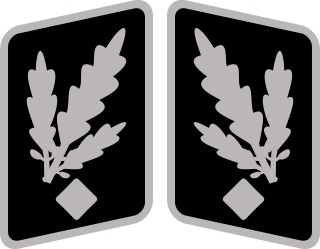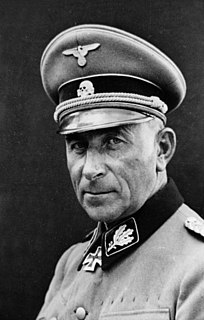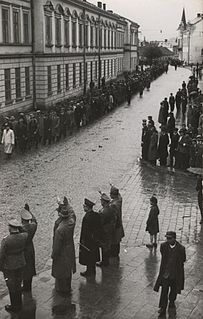
The Waffen-SS was the combat branch of the Nazi Party's Schutzstaffel (SS) organisation. Its formations included men from Nazi Germany, along with volunteers and conscripts from both occupied and unoccupied lands.

Gottlob Christian Berger was a senior German Nazi official who held the rank of SS-Obergruppenführer und General der Waffen-SS and was the chief of the SS Main Office responsible for Schutzstaffel (SS) recruiting during World War II. At the post-war Nuremberg trials, the Waffen-SS – within which Berger was a senior officer – was declared to be a criminal organisation due to its major involvement in war crimes and crimes against humanity. Berger was convicted as a war criminal and spent six and a half years in prison.

Flecktarn is a family of 3-, 4-, 5- or 6-color disruptive camouflage patterns, the most common being the five-color pattern, consisting of dark green, light green, black, red brown and green brown or tan depending on the manufacturer. The original German 5-color pattern was designed for use in European temperate woodland terrain. A 3-color variation called Tropentarn is intended for arid and desert conditions; the German Bundeswehr wore it in Afghanistan.

Gruppenführer was an early paramilitary rank of the Nazi Party (NSDAP), first created in 1925 as a senior rank of the SA. Since then, the term Gruppenführer is also used for leaders of groups/teams of the police, fire departments, military and several other organizations.

The uniforms and insignia of the Schutzstaffel were used for the Nazi paramilitary ranks of the Schutzstaffel (SS) between 1925 and 1945 to differentiate that organization from the Wehrmacht as the regular German armed forces, the German state, and the Nazi Party.

Paul Hausser was a German general and then a high-ranking commander in the Waffen-SS who played a key role in the post-war efforts by former members of the Waffen-SS to achieve historical and legal rehabilitation.
SS-Verfügungstruppe was formed in 1934 as combat troops for the Nazi Party (NSDAP). On 17 August 1938 Adolf Hitler decreed that the SS-VT was neither a part of the Ordnungspolizei nor the Wehrmacht, but military-trained men at the disposal of the Führer. At the time of war, the SS-VT were to be placed at the disposal of the army.

A combat uniform, also called field uniform, battledress or military fatigues, is a casual type of uniform used by military, police, fire and other public uniformed services for everyday fieldwork and combat duty purposes, as opposed to dress uniforms worn in functions and parades. It generally consists of a jacket, trousers and shirt or T-shirt, all cut more loose and comfortable than more formal uniforms. Design may depend on regiment or service branch, e.g. army, navy, air force, marines, etc. In the army branches, fabrics tend to come in camouflage, disruptive pattern or else green, brown or khaki monochrome, in order to approximate the background and make the soldier less visible in nature. In Western dress codes, field uniform is considered equivalent to civilian casual wear. As such, field uniform is considered less formal than service dress uniform, generally aimed at office or staff use, as well as mess dress uniform, and full dress uniform.

Military camouflage is the use of camouflage by an armed force to protect personnel and equipment from observation by enemy forces. In practice, this means applying colour and materials to military equipment of all kinds, including vehicles, ships, aircraft, gun positions and battledress, either to conceal it from observation (crypsis), or to make it appear as something else (mimicry). The French slang word camouflage came into common English usage during World War I when the concept of visual deception developed into an essential part of modern military tactics. In that war, long-range artillery and observation from the air combined to expand the field of fire, and camouflage was widely used to decrease the danger of being targeted or to enable surprise. As such, military camouflage is a form of military deception.

The Latvian Legion was a formation of the German Waffen-SS during World War II. Created in 1943, it consisted primarily of ethnic Latvian personnel. The legion consisted of two divisions of the Waffen-SS: the 15th Waffen Grenadier Division of the SS, and the 19th Waffen Grenadier Division of the SS. The 15th Division was administratively subordinated to the VI SS Corps, but operationally it was in reserve or at the disposal of the XXXXIII Army Corps, 16th Army, Army Group North. The 19th Division held out in the Courland Pocket until May 1945, the close of World War II, when it was among the last of Nazi Germany's forces to surrender.
HIAG was a lobby group and a denialist veterans' organisation founded by former high-ranking Waffen-SS personnel in West Germany in 1951. Its main objective was to achieve legal, economic, and historical rehabilitation of the Waffen-SS.

The following is a general overview of the Heer main uniforms, used by the German army prior to and during World War II.

Splittertarnmuster, Splittertarn or Splittermuster (splinter-pattern) is a four-colour military camouflage pattern developed by Germany in the late 1920s, first issued to the Reichswehr in 1931.

The Wehrmacht was the unified armed forces of Nazi Germany from 1935 to 1945. It consisted of the Heer (army), the Kriegsmarine (navy) and the Luftwaffe. The designation "Wehrmacht" replaced the previously used term Reichswehr and was the manifestation of the Nazi regime's efforts to rearm Germany to a greater extent than the Treaty of Versailles permitted.

During World War II, the Waffen-SS recruited significant numbers of non-Germans, both as volunteers and conscripts. In total some 500,000 non-Germans and ethnic Germans from outside Germany, mostly from German-occupied Europe, were recruited between 1940 and 1945. The units were under the control of the SS Führungshauptamt beneath Reichsführer-SS Heinrich Himmler. Upon mobilization, the units' tactical control was given to the Oberkommando der Wehrmacht.

M1929 Telo mimetico was a military camouflage pattern used by the Italian Army for shelter-halves and later for uniforms for much of the 20th century. Being first issued in 1929 and only fully discontinued in the early 1990s, it has the distinction of being the first printed camouflage pattern for general issue, and the camouflage pattern in longest continuous use in the world.

German World War II camouflage patterns formed a family of disruptively patterned military camouflage designs for clothing, used and in the main designed during the Second World War. The first pattern, Splittertarnmuster, was designed in 1931 and was initially intended for Zeltbahn shelter halves. The clothing patterns developed from it combined a pattern of interlocking irregular green, brown, and buff polygons with vertical "rain" streaks. Later patterns, all said to have been designed for the Waffen-SS by Johann Georg Otto Schick, evolved into more leaf-like forms with rounded dots or irregular shapes. Camouflage smocks were designed to be reversible, providing camouflage for two seasons, whether summer and autumn, or summer and winter (snow). Distribution was limited to the Waffen-SS, ostensibly because of a patent, though variants were used by other units, including the Luftwaffe. Production was limited by shortage of materials, especially of high quality waterproof cotton duck.
The Waffen-SS, the combat branch of the paramilitary SS organisation of Nazi Germany, is often portrayed uncritically or admiringly in popular culture.

Snow camouflage is the use of a coloration or pattern for effective camouflage in winter, often combined with a different summer camouflage. Summer patterns are typically disruptively patterned combinations of shades of browns and greys, up to black, while winter patterns are dominated by white to match snowy landscapes.

The TAZ 83 is a military camouflage pattern used by the Swiss Army for the Kampfanzug 57/70 and the TAZ 83. It also is known as "Alpenflage" or "pizza camouflage" among collectors of militaria as military surplus camouflage clothing it came on to the army surplus market in the 1990s.


















